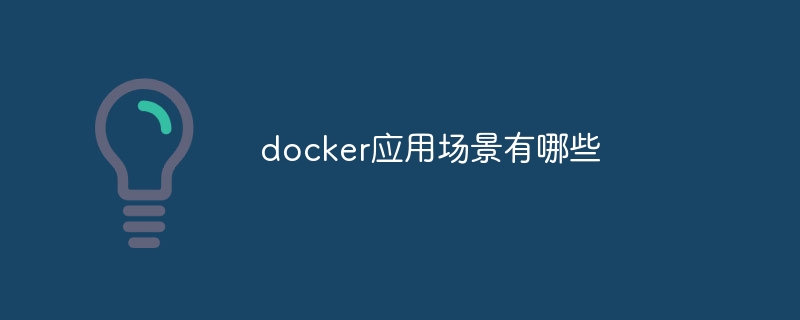What are the docker application scenarios
Docker is suitable for a wide range of application scenarios, including: microservice architecture, CI/CD, isolation, cloud computing, container orchestration, database management, and DevOps and team collaboration.

Docker application scenarios
Docker is a containerized technology that has become an integral part of modern software development and delivery. It provides isolation, portability and efficiency, making it suitable for a wide range of application scenarios.
1. Microservice architecture
Docker is ideal for building microservice architectures. Microservices are small, autonomous components that are independently deployed and expanded. Docker's isolation enables microservices to run independently of each other without worrying about resource conflicts or dependencies.
2. Continuous Integration and Deployment (CI/CD)
Docker plays a crucial role in the CI/CD pipeline. It enables developers and operations engineers to create repeatable, consistent environments for building, testing, and deploying applications. Docker images can be easily shared and versioned, simplifying the deployment process.
3. Isolation and Resource Management
Docker containers create separate sandbox environments on the host operating system. This provides isolation to prevent applications from interfering with each other or accessing sensitive data. Docker also allows users to effectively manage resources such as CPU, memory, and storage to optimize performance.
4. Cloud computing
Docker integrates very well with cloud computing platforms such as AWS, Azure, and Google Cloud. It enables developers to easily deploy applications to the cloud, leveraging their scalability and high availability. Docker containers can be easily migrated across cloud environments, improving agility and portability.
5. Container orchestration
Container orchestration tools such as Docker Compose and Kubernetes enable enterprises to manage and orchestrate multiple Docker containers. This is crucial for large-scale deployment, service discovery and automation tasks.
6. Database Management
Docker can be used to create isolated database environments for development, testing, and production. It reduces the complexity of database configuration and management and simplifies the backup and recovery process.
7. DevOps and teamwork
Docker removes barriers between development and operation teams. It provides all team members with a consistent view of the application environment, facilitating communication and collaboration. The sharing and repeatability of Docker images enables teams to focus on feature development rather than environment configuration.
The above is the detailed content of What are the docker application scenarios. For more information, please follow other related articles on the PHP Chinese website!

Hot AI Tools

Undresser.AI Undress
AI-powered app for creating realistic nude photos

AI Clothes Remover
Online AI tool for removing clothes from photos.

Undress AI Tool
Undress images for free

Clothoff.io
AI clothes remover

Video Face Swap
Swap faces in any video effortlessly with our completely free AI face swap tool!

Hot Article

Hot Tools

Notepad++7.3.1
Easy-to-use and free code editor

SublimeText3 Chinese version
Chinese version, very easy to use

Zend Studio 13.0.1
Powerful PHP integrated development environment

Dreamweaver CS6
Visual web development tools

SublimeText3 Mac version
God-level code editing software (SublimeText3)

Hot Topics
 How to exit the container by docker
Apr 15, 2025 pm 12:15 PM
How to exit the container by docker
Apr 15, 2025 pm 12:15 PM
Four ways to exit Docker container: Use Ctrl D in the container terminal Enter exit command in the container terminal Use docker stop <container_name> Command Use docker kill <container_name> command in the host terminal (force exit)
 How to copy files in docker to outside
Apr 15, 2025 pm 12:12 PM
How to copy files in docker to outside
Apr 15, 2025 pm 12:12 PM
Methods for copying files to external hosts in Docker: Use the docker cp command: Execute docker cp [Options] <Container Path> <Host Path>. Using data volumes: Create a directory on the host, and use the -v parameter to mount the directory into the container when creating the container to achieve bidirectional file synchronization.
 How to check the name of the docker container
Apr 15, 2025 pm 12:21 PM
How to check the name of the docker container
Apr 15, 2025 pm 12:21 PM
You can query the Docker container name by following the steps: List all containers (docker ps). Filter the container list (using the grep command). Gets the container name (located in the "NAMES" column).
 How to restart docker
Apr 15, 2025 pm 12:06 PM
How to restart docker
Apr 15, 2025 pm 12:06 PM
How to restart the Docker container: get the container ID (docker ps); stop the container (docker stop <container_id>); start the container (docker start <container_id>); verify that the restart is successful (docker ps). Other methods: Docker Compose (docker-compose restart) or Docker API (see Docker documentation).
 How to start mysql by docker
Apr 15, 2025 pm 12:09 PM
How to start mysql by docker
Apr 15, 2025 pm 12:09 PM
The process of starting MySQL in Docker consists of the following steps: Pull the MySQL image to create and start the container, set the root user password, and map the port verification connection Create the database and the user grants all permissions to the database
 How to update the image of docker
Apr 15, 2025 pm 12:03 PM
How to update the image of docker
Apr 15, 2025 pm 12:03 PM
The steps to update a Docker image are as follows: Pull the latest image tag New image Delete the old image for a specific tag (optional) Restart the container (if needed)
 How to create containers for docker
Apr 15, 2025 pm 12:18 PM
How to create containers for docker
Apr 15, 2025 pm 12:18 PM
Create a container in Docker: 1. Pull the image: docker pull [mirror name] 2. Create a container: docker run [Options] [mirror name] [Command] 3. Start the container: docker start [Container name]
 How to start containers by docker
Apr 15, 2025 pm 12:27 PM
How to start containers by docker
Apr 15, 2025 pm 12:27 PM
Docker container startup steps: Pull the container image: Run "docker pull [mirror name]". Create a container: Use "docker create [options] [mirror name] [commands and parameters]". Start the container: Execute "docker start [Container name or ID]". Check container status: Verify that the container is running with "docker ps".






